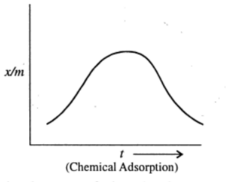 Short Answer Type
Short Answer TypeIn the case of physical adsorption the extent of adsorption (x/m) decrease with increase of temperature, as most of the adsorption processes are exothermic with increase n temperature the kinetic energy of the molecule increase and they try to escape from the surface and hence physical adsorption decrease with increase in temperature.



(i) What is the charge of AgI colloidal particles in the two test tube (A) and (B).
(ii) Give reason for the origin of change.
 Long Answer Type
Long Answer Type Short Answer Type
Short Answer Type(i) How are the values of k and n determined experimentally?
(ii) Explain why the value of n should be equal to or greater than one?
 Long Answer Type
Long Answer TypeExplain the following observations:
(a) Ferric hydroxide sol gets coagulated on addition of sodium chloride solution.
(b) Cottrell’s smoke precipitator is fitted at the mouth of the chimney used in factories.
(c) Physical adsorption is multi layered, while chemisorption non layered.
 Short Answer Type
Short Answer Type